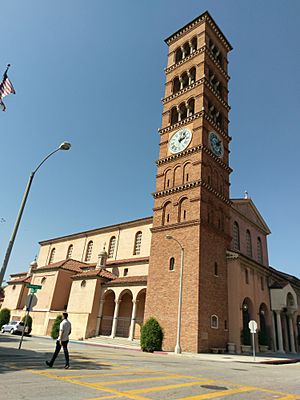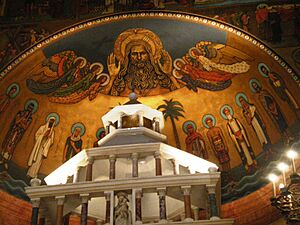St. Andrew's Catholic Church (Pasadena, California) facts for kids
Quick facts for kids St. Andrew Catholic Church |
|
|---|---|
 |
|
| 34°09′02″N 118°08′58″W / 34.15066°N 118.14933°W | |
| Location | 311 N. Raymond Avenue Pasadena, California 91103 |
| Country | |
| Denomination | Roman Catholic |
| Website | saintandrewpasadena.org |
| History | |
| Founded | 1886 |
| Dedicated | 1927 (current church building) |
| Architecture | |
| Architect(s) | Ross Montgomery Robert Brown Young |
| Architectural type | Romanesque Revival; Byzantine Revival |
| Construction cost | $1,000,000 |
| Administration | |
| Diocese | Archdiocese of Los Angeles |
| Division | San Gabriel Pastoral Region |
St. Andrew's Catholic Church is a Catholic church located in Pasadena, California. It was founded in 1886, making it the oldest Catholic parish in Pasadena. It is also one of the oldest in Los Angeles County. The church's tall bell tower, called a campanile, can be seen from far away. It is a famous landmark in Pasadena. The inside of the church, built in 1927, looks like the Basilica of Santa Sabina in Rome. The front of the church looks like the Santa Maria in Cosmedin church, also in Rome.
Contents
The Church Building: A Pasadena Landmark
The current St. Andrew's Church building was finished in 1927. It cost about $1,000,000 to build. Many people think it is one of the most beautiful and important churches in Southern California. The building's style, both inside and out, is like early Christian churches from the Byzantine era.
The architect, Ross Montgomery, and the church's pastor, John Michael McCarthy, traveled to Italy. They studied old Byzantine buildings to get ideas for the new church in Pasadena. The Los Angeles Times newspaper later said that their teamwork created a building that would be remembered for a long time. Montgomery and McCarthy were mainly inspired by the Santa Sabina basilica in Rome, built in 432 A.D. They used it as a model for St. Andrew's.
In May 1928, a special dedication Mass was held. Hundreds of children took part in a religious parade at 6 a.m. The Blessed Sacrament was carried from the old church to the new one. Bishop John Cantwell said the new church was "the pride of the diocese." He called it a great copy of the old church in Rome.
In 1930, the Los Angeles Times wrote about the church. They said Pasadena had a new special feature: "In the heart of Pasadena... rises beautiful St. Andrew's Catholic Church." They believed the church's building and decorations started a new time for religious architecture on the Pacific Coast.
The Architectural Guidebook to Los Angeles describes St. Andrew's. It says the church has an early Christian design with a Romanesque bell tower. The book mentions that the rich inside of the church is amazing. It also says the church's shape adds a lot to the city view.
Carlo Wostry Murals: Art Inside the Church
Even though the church building was finished in 1927, it took eight more years to complete the paintings, called murals, and other decorations inside. The church asked an Italian painter named Carlo Wostry to create the murals and the Stations of the Cross. Wostry had painted murals in other cities like Trieste, Venice, Paris, and New York. But he felt his work at St. Andrew's was the best of his artistic life.
He spent five years decorating the inside of St. Andrew's. He worked both at the church and in a quiet studio in the Hollywood Hills. At first, he was asked to paint the murals above the altar. The church members loved his work so much that they raised money for him to paint the chapel in the north part of the church. Wostry spent a year painting the Madonna (Mary) sitting on a throne with angels above her.
In 1932, Wostry was asked to paint the Stations of the Cross. He went back to Trieste to finish this work. When the Los Angeles Times saw Wostry's murals in Pasadena in 1930, they called him "a worthy descendant of the great Italian mural painters of the Renaissance." Twenty-four of Wostry's murals were shown in Trieste before they were sent to Pasadena. An Italian newspaper was sad that the artworks were leaving Italy. They thought they were going to a place "where the people have money but no genuine art appreciation." When all his work was done in 1935, the Los Angeles Times wrote that Wostry's murals at St. Andrew's were "a revelation to the western art world." They said they were the best "in any church in the two Americas."
Parish History: A Community's Journey
Early Years (1886–1918)
In 1886, Patrick Harnett from the Cathedral of Saint Vibiana in Downtown Los Angeles was asked to start a new church community. This was for the Catholic people living in the Pasadena area. Before this, local Catholics had to travel to the San Gabriel Mission or to Downtown Los Angeles for Mass. The very first Mass in Pasadena was held at a hotel. In 1888, the first priest, Andrew Cullen, named the church parish for St. Andrew.
In April 1906, after the big 1906 San Francisco earthquake, a special Mass was held at St. Andrew's. It was to remember those who died in San Francisco. The church was decorated in black, and sad music was played by a full choir. The Los Angeles Times reported that about a thousand people attended. This included many city leaders and people from other churches.
John Michael McCarthy (1918–1944)
John Michael McCarthy was the fifth pastor of St. Andrew's. He was from Brooklyn, New York. He served for 26 years, from 1918 to 1944. He was one of the first priests in California to be called a monsignor. He was known as the "adobe priest" because he cared deeply for the Mexican people. He was also called the "padre of the boulevard." This was because he walked the streets of Pasadena every day. He would offer advice and help to people who needed it.
His successor, Bishop McGucken, said that McCarthy's daily walks were like a sacred mission. During McCarthy's time as pastor, the church opened a high school. In 1927, the current church building was constructed. McCarthy stayed at St. Andrew's as a pastor emeritus from 1944 until he passed away in 1951. About 800 church members and officials attended his funeral.
The McGucken and Hourihan Years (1944–1982)
Bishop Joseph T. McGucken took over as pastor after McCarthy. He was from Los Angeles. He served at St. Andrew's from 1944 to 1955. Besides being pastor, Bishop McGucken was also a very important leader in the Los Angeles Archdiocese. In 1955, he left St. Andrew's when he became the Bishop of Sacramento. The church community held a big farewell party for him. Bishop McGucken later became the Archbishop of San Francisco from 1962 to 1977.
St. Andrew's also had another long-serving priest named James Hourihan. He was from Ireland. He first served as an assistant pastor from 1931 to 1936. Then he became pastor for 27 years, from 1955 to 1982. In 1986, Hourihan wrote a 224-page book about the history of St. Andrew's church.
Recent Years
Tobias P. English, who was an Air Force veteran, was pastor at St. Andrew's from 1982 to 1999. After he retired, he remained at St. Andrew's as a pastor emeritus.
After Hurricane Katrina, the St. Andrew's church community helped a young mother and her baby daughter. They paid their apartment rent for six months. The church council also gave them a crib, Christmas gifts, and emotional support.
In July 2004, the associate pastor, Marcos Gonzalez, was featured in a long article in the Los Angeles Times. The article talked about a "new breed" of priests who were very traditional. Gonzalez, who was born in Fidel Castro's Cuba, said two people were very important to him growing up: "John Paul in my church life and Ronald Reagan in my civil life." Gonzalez was known for his strong sermons about church teachings. One long-time church member said she was "startled and gratified" by his sermons. She felt that older priests sometimes avoided these topics, but Gonzalez was not afraid to speak out. The pastor at the time, Frank Colborn, noted that many younger priests like Gonzalez did not share his strong interest in working with other religions or social justice issues. However, Colborn also said he understood the concern about people not following church teachings. He said, "We're not in the business of throwing people out of the church, but we need to find some way to get people to take seriously that the church does stand for something." Marcos Gonzalez became the pastor of St. Andrew's in 2019.
The School: Learning and Faith
In 1897, the church opened a Catholic school. It was first called the "Academy of Holy Names." Later, it was renamed St. Andrew Catholic School. The Sisters of the Holy Names of Jesus and Mary ran the school. In 1898, they bought land to build a permanent brick school building. The school moved to its current location in 1923. The school building that stands today was built in 1949.
While he was still a cardinal, Pope Pius XII visited St. Andrew's Church and School. Sister Mary Petra remembered, "He blessed us and admired our church." The high school part of the school closed in 1980. In September 1997, hundreds of former students of St. Andrew School came together for a reunion. They celebrated the school's 100th anniversary.
Pastors of St. Andrew's
Here are the priests who have served as pastor at St. Andrew's:
- Andrew Cullen, 1888–1890
- Cornelius Scannel, 1890–1896
- Patrick Farrelly, 1897–1909
- William Quinlan, 1909–1918
- John M. McCarthy, 1918–1944
- Joseph Thomas McGucken, 1944–1955
- James Hourihan, 1955-1982 (He was also an assistant pastor from 1931–1937 and pastor emeritus from 1982–1997)
- Tobias P. English, 1982 to 1999
- Frank Colborn, 1999 to 2007
- Paul Sustayta, 2007 to 2019
- Marcos Gonzalez, 2019–Present
Mass Schedule
As of 2025, here is the Mass schedule at St. Andrew Church, Pasadena:
- Weekdays (English): 8:15 a.m. (Monday - Friday)
- Weekdays (Spanish): 6:30 p.m. (Monday - Friday)
- Saturdays: 8:15 a.m. and 5:00 p.m. (vigil)
- Sundays: 6:30 a.m. (Spanish), 8:00 a.m. (English), 9:30 a.m. (English), 11:00 a.m. (Spanish), 12:30 p.m. (English), 2:00 p.m. (Spanish) and 5:00 p.m. (English)
- Tuesday Holy Hour (Adoration and Benediction of the Blessed Sacrament and Confessions) 7:00 p.m - 8:00 p.m
- Friday Confessions 9:00 a.m. and 7:00 p.m.
- Saturday Confession 4:00 p.m. and 7:00 p.m.
See also
- San Gabriel Pastoral Region



